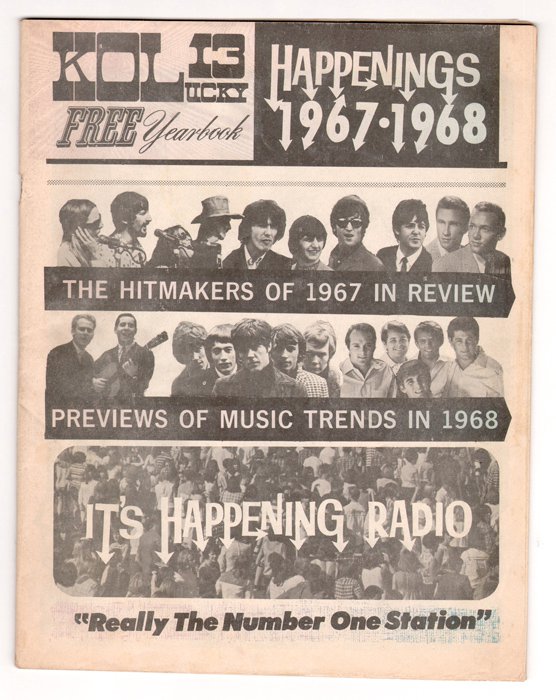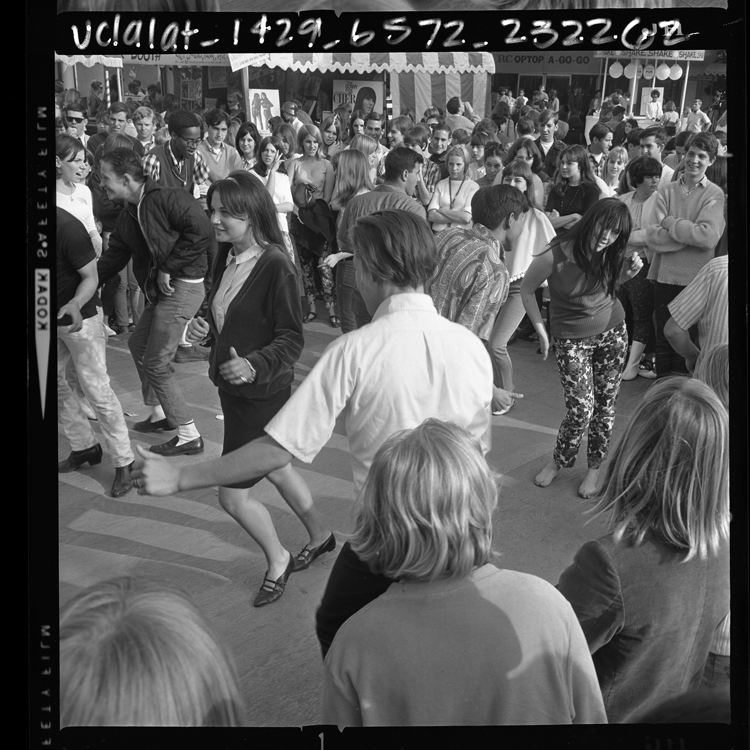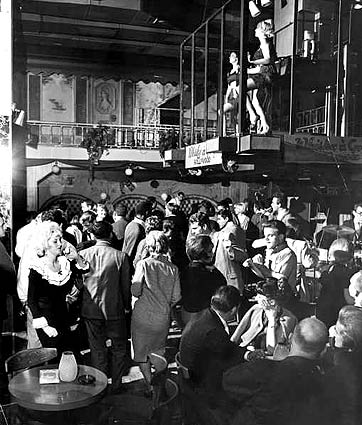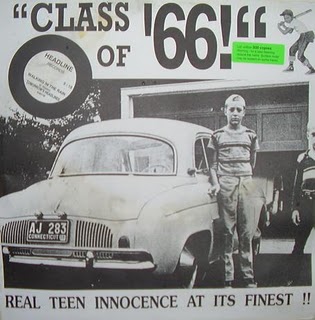before the big corporate money began pouring its cold soul into popular music culture….
Art Chantry (art@artchantry.com):
Before there was Rolling Stone magazine, before we had ‘rock critics’, before we had ‘genres’ of rock music, there was only radio. They were the masters of ceremony, the promoters of the music, the only reason it survived – ‘cuz they could make a buck.
When I was a kid, radio stations like (in the northwest) Pat O’Day’s and Dick Curtiss’s KJR and (a little later) stations like KOL FM were the only way to hear the music, taste the lifestyle, feel the freedom, pick up the cool. They were the beacons of the future of youth culture. Without them, we would have had nothing. It couldn’t be more completely the opposite of today.
To give you an idea of how powerful these staions could be, KJR, at it’s peak, had something like a 60% share of the listening public. Think about that for a minute. a 60% share of the market. That’s ENORMOUS. It was one of the most powerful radio stations in the industry, in the nation. “KJR GO-GO” buttons are still popular among hipsters today. Everybody in the who grew up in the region can still sing the “KJR seattle/channel 95″ jingle.

AC:this was before this 'level' gave much thought about 'creative credits'. back then, creativity was saved for 'quality' projects. the idea that anybody would want 'creative' credit for something like this would have been laughable.
Guys like Pat O’Day were local godheads. They were the people who made the choices, created the standards that we all paid attention to. He told us what was cool, what was worth listening to, what was worth seeing. We all followed like the little children following the pied piper. He marched us into the world we have now – for better or for worse.
One of the many strange things that powerful rock n roll radio stations did at the time was host enormous ‘teen fairs.’ It began in Los Angeles, the HUB of rock culture at the time (mid sixties) when they began holding teen fairs where the kids could go buy fashion, listen to music, hang out and meet each other, and actually see their favorite pop groups!
At the time, in Los Angeles, that meant dragging in famous british invasion bands and national stars. You’d have the Rolling Stones and the Animals playing next to the Righteous Brothers and Ike and Tina and Chuck Berry. There’d be lots of local surf bands like the Beach Boys and Jan and Dean and the Surfaris. And then you’d have all the new bands with hit singles on the radio trying to sell their product – bands like the Buffalo Springfield, the Seeds, Question Mark & Amp; the Mysterians, Paul Revere & the Raiders, Captain Beefheart and his Magic Band. Amazing line-ups.

teen fair 1966. Hollywood Palladium. ---In his book "The American Hot Rod" Dean Batchelor recounts his time during the war working at Lockheed. He relates a story of heading off to the dry lakes early on a Sunday morning early am and returning later that day and heading out to the Hollywood Palladium. Anyone have any pics of this venue in the day? Dean also refers to other big band venues including the Rendezvous Ballroom , Trianon , Meadowbrook and Ocean Park Pier ballrooms. Anyone have any pics of these places in the day as well? These places played the pop music of the day. An interesting background context to the early days of hot rodding.--- click image for more...
To top it all
, they’d have a ‘battle of the bands’ where the bands would play their best shots and then the kids would “vote” on them. The bands the kids loved the most “won” the battle. Sometimes, it meant an actual award or something. But, mostly, it just meant a HUGE amount of prestige and a quantum leap in the live performance attendance (and record sales, if they had records to sell). It was a gas. All the latest dances, too!
Pat O’Day in Seattle paid close attantion, too. He began having armory and dances held in old roadhouses like the Spanish Castle Ballroom. He booked bands from all over, the same bigshot bands they had in LA, bristish invasion bands, local bands. it peaked with the Pat O’Day and Dick Curtiss sponsored “teen spectaculars” held on the grounds of the old Seattle worlds fair. I believe there were two or three of them (65-68).
The line-ups were astonishing to behold. You could hang out for a weekend and see the Buffalo Springfield, the Rolling Stones, the Byrds, Jimi Hendrix, the Sonics, the Raiders, the Liverpool Five, Merrilee Rush & the Turnabouts, the Wailers, the Who (!), the Shangri-Las (with the sonics backing them), Mitch Ryder & the Detroit Wheels, the Dave Clark Five, the Mamas & the Papas and on and on and and on. Pat O’Day built his booking empire called ‘concerts west’ out of these efforts and he dominated live music in the northwest (as well as radio) for decades to come.
Some of the strange things that came out of these events? I guess Pat O’day takes credit for conceiving that most bizarre of all tour pairings in rock n roll history – the Monkees with the Jimi Hendrix experience as the warm up act. It didn’t work out very well.
Another peculiar thing was the ‘stage in the round’. It was literally a roughly circular stage (more of a ten sided shape). underneath was a rig where the whole thing would turn on a track guided by volkswagon tires. A couple of guys would hide under it and push and it would slowly turn in a circle. Imagine watching the who in 1965 performing on a circular revolving stage in the middle of a 30,000 seat coliseum packed to the gills with screaming teenagers. Hard to imagine, actually.
Things, of course, were changing rapidly. The Vietmnam War was starting to loom as a the threat of inevitable draft and early death. lsd finally hit up in the northwest. Everybody got a tad older and hipper and moved on. Within a year of the final teen spectacular, Pat ‘daDy’s assistant, Boyd Grafmyre, held the Seattle Pop Festival (with a young led zeppelin, the doors, and a host of bands with surreal names (from san francisco) and killed off the teen fair forever.

---'The Whisky' opened it's doors on January 1964 and was and still is located at 8901 Sunset Blvd , this tiny venue originally opened as a discotheque (meaning they could only legally play records). The venue in it's early incarnation always broke this rule and opened with a live band in the form of Johnny Rivers, whilst a short skirted female DJ by the name of Rhonda Lane spun records in a suspended cage. Many bands including Love, The Doors, The Byrds, The Seeds, The Standells, Buffalo Springfield all played shows here (the venue also became pretty important during the 70s L.A punk scene & 80s hair metal scenes) Due to Rhonda Lanes' suspension in a cage the crowds went wild and thought it was part of the show and this began what is now known as go-go dancing, The Whisky A G0-Go was the venue which popularised the craze and before the end of the 60s the go-go dance became a notable feature in 60s dance culture (these hip fads even made it to Television and beyond - even Batman and Robin dug it)--- click image for more:
The Seattle Pop Festival was quickly followed by the ‘sky river rock festival (and lighter than air fair) – the very first outdoor rock festival ever held anywhere in the world. radio listening switched to FM (KJR was AM) and the old world all vanished in a puff of smoke.
So, it’s with a great deal of curiosity that I began to collect and examine the PUBLICATIONS of these old radio stations. Yes, they made little ‘magazines’. They were a sort of combination of radio promotion combined with adverts and profiles of popular bands with lots of airplay. There would be articles that were sort of primituve early record reviews and concert reviews. They were part ‘tiger beat’ and part ‘rolling stone (before it existed). Radio station magazines are a real treasure. These little radio publications became the prototype of the rock full blown rock magazines like Rolling Stone and Creem.
Best of all were the interviews with various bands – some famous and some so obscure that they are totally lost in time. These crummy little publications (always printed on cheap newsprint) have become the only documentation of much of this mid sixties culture of the teen pop culture explosion that was the first truly huge manifestation of boomer culture.
I enjoy reading these things. they are VERY hard to find – they all got tossed out as trash. They are a window in a period of primordial development of a more stabilized pop culture dialog. They are so confused and confusing and charming and sad. A rough first step forward into a truly stratified, cleanly sliced and diced popular youth culture that our corporate world created for us (and with us.)
At this juncture in time, they had no idea what they were doing. And that’s what I love.
Read More:http://itsmashedpotatotime.blogspot.com/2010/10/teen-go-go-night-spots-in-60s-los.html









 COMMENTS
COMMENTS



